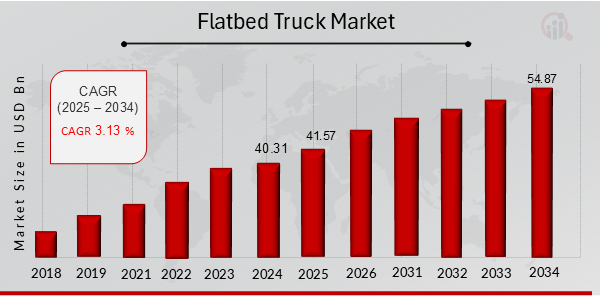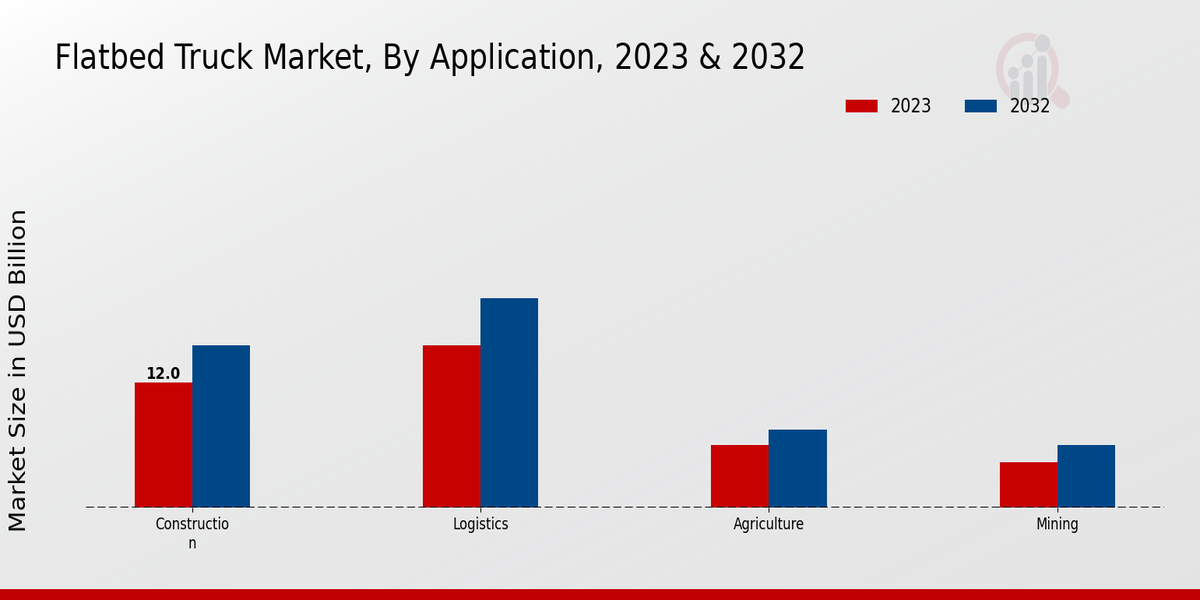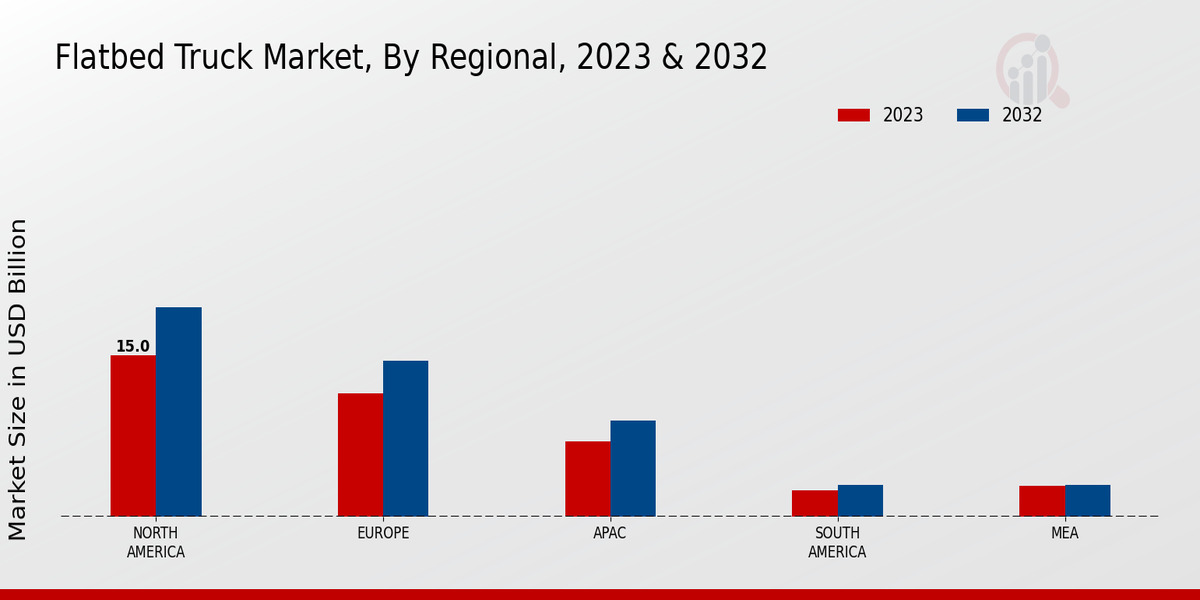Flatbed Truck Market Overview:
As per MRFR analysis, the Flatbed Truck Market Size was estimated at 40.31 (USD Billion) in 2024. The Flatbed Truck Market Industry is expected to grow from 41.57 (USD Billion) in 2025 to 54.87 (USD Billion) till 2034, at a CAGR (growth rate) is expected to be around 3.13% during the forecast period (2025 - 2034).
Key Flatbed Truck Market Trends Highlighted
The Flatbed Truck Market is currently experiencing notable growth, driven primarily by the increasing demand for efficient logistics and transportation solutions. Key market drivers include the rise in e-commerce activities, which require prompt and reliable delivery of goods. The construction and infrastructure sectors also contribute to this demand, as flatbed trucks are essential for transporting heavy equipment and materials. Furthermore, the expansion of trade activities, particularly in developing regions, creates a persistent need for versatile transport options, emphasizing the practical use and efficiency of flatbed trucks.
There are various opportunities to be explored in this market, such as advancements in technology, which can enhance the efficiency of flatbed trucks.The integration of automation and telematics in logistics operations holds promise for better fleet management and reduced operational costs. Additionally, the growing trend of sustainable transportation opens avenues for manufacturers to innovate and provide eco-friendly flatbed trucks, appealing to a more environmentally conscious consumer base. Moreover, the shift towards electric and hybrid models in the transportation industry presents a significant opportunity for growth in the flatbed segment. Recent trends indicate a focus on customization and adaptability in flatbed truck design, catering to the unique requirements of various industries.The move towards online platforms for purchasing and leasing these trucks reflects changing consumer behavior and preferences.
Additionally, increasing collaborations between manufacturers and technology companies are becoming commonplace to enhance service offerings. These trends signify a meaningful shift in how flatbed trucks are utilized, showcasing their importance in modern logistics and reinforcing their position in the transportation sector. As the market continues to evolve, the emphasis on efficiency, sustainability and technology integration will likely shape its future landscape.

Source: Primary Research, Secondary Research, MRFR Database and Analyst Review
Flatbed Truck Market Drivers
Increasing Demand for Efficient Transportation Solutions
The Flatbed Truck Market Industry is experiencing significant growth driven by the increasing demand for efficient transportation solutions across various sectors. Flatbed trucks are designed to transport heavy and oversized loads, making them ideal for industries such as construction, agriculture, and manufacturing. Their versatility allows for easy loading and unloading of materials, which is crucial for businesses that operate in fast-paced environments.Additionally, the rise of e-commerce and the need for rapid delivery services have accentuated the demand for reliable and efficient transport methods.
As companies seek to streamline their logistics and reduce operational costs, flatbed trucks provide a practical solution that can enhance delivery times and improve overall productivity. Furthermore, advancements in technology have enabled manufacturers to develop flatbed trucks that are not only robust and long-lasting but also equipped with features that enhance safety and efficiency.These innovations contribute to meeting the growing consumer expectations for timely transportation. Consequently, the increasing demand for flatbed trucks and their essential role in facilitating trade and commerce positions the Flatbed Truck Market Industry for continued growth in the coming years.
Growth of the Construction and Infrastructure Sector
The Flatbed Truck Market Industry is significantly driven by the growth of the construction and infrastructure sector. As urbanization continues to rise, the demand for construction-related transportation services has escalated. Flatbed trucks facilitate the movement of materials such as steel, lumber, and heavy machinery, which are essential for construction projects. The ongoing investments in infrastructure projects by both public and private entities are fueling the need for reliable transportation solutions, thus enhancing the demand for flatbed trucks.These vehicles are particularly invaluable for transporting large items that require specialized handling, contributing to the overall efficiency of construction operations.
Technological Advancements and Innovation
Technological advancements play a pivotal role in driving the Flatbed Truck Market Industry forward. Manufacturers are increasingly adopting innovative technologies such as telematics, GPS tracking and enhanced safety features in their flatbed trucks. These innovations not only improve operational efficiency but also enhance safety during transit, which is a paramount concern for fleet operators. The integration of smart technologies helps in tracking vehicle performance, optimizing routes, and ensuring timely deliveries.As these technological enhancements become standard, they raise consumer expectations for product reliability and performance, thus propelling the growth of the flatbed truck market.
Flatbed Truck Market Segment Insights:
Flatbed Truck Market Application Insights
The Flatbed Truck Market, valued at 37.9 USD Billion in 2023, reflects a diverse range of applications that significantly contribute to its growth. The Applications segment includes key areas such as Construction, Logistics, Agriculture and Mining, each representing a crucial facet of market dynamics. The Construction segment, valued at 12.0 USD Billion in 2023, plays a significant role, serving as a backbone for infrastructure development activities. This sector not only illustrates a robust demand for flatbed trucks due to their essential contributions to transporting equipment and materials but also anticipates substantial growth, reaching 15.5 USD Billion by 2032. In parallel, the Logistics sector dominates the Flatbed Truck Market, currently valued at 15.5 USD Billion in 2023 and expected to surge to 20.0 USD Billion by 2032. This sector's importance is marked by its vital role in facilitating the efficient movement of goods, showcasing a significant demand for flatbed trucks as they provide critical solutions for a variety of freight types, including oversized and bulky items that require careful handling.
The Agriculture sector, valued at 6.0 USD Billion in 2023, also contributes to the overall market, with its primary focus on transporting agricultural products, machinery, and supplies across farms. This sector demonstrates steady growth potential as agricultural activities expand ly, reflecting an increase in the demand for specialized transport solutions, which flatbed trucks are capable of providing. By 2032, the agriculture segment is projected to reach a valuation of 7.5 USD Billion.Additionally, the Mining segment, valued at 4.4 USD Billion in 2023 and expected to grow to 6.0 USD Billion by 2032, is crucial for transporting heavy equipment and mined material to processing sites. Despite being the smallest segment in terms of valuation, its importance cannot be understated, as mining operations rely heavily on flatbed trucks for efficient handling and transport in often challenging terrains.
The overall Application segment of the Flatbed Truck Market showcases a clear segmentation of needs across these industries and reflects the broader trends in economic development and infrastructure investments, influencing transport requirements. As industries like Construction and Logistics continue to dominate, they underscore the growing demand and strategic value of flatbed trucks in facilitating operations across diverse sectors, thus highlighting the importance of the Flatbed Truck Market revenue in the broader economic context. This property of flatbed trucks to adapt to various high-utility sectors amplifies their relevance, creating significant opportunities for growth, adapting to emerging trends, and addressing environmental challenges within these applications.

Source: Primary Research, Secondary Research, MRFR Database and Analyst Review
Flatbed Truck Market Type Insights
The Flatbed Truck Market is expected to witness Within this market, the Type segment is categorized into Light Duty, Medium Duty and Heavy Duty trucks, each playing a vital role in meeting the varying demands of transportation. Light Duty trucks are crucial for urban deliveries and are often preferred for their efficiency and maneuverability. In contrast, medium-duty trucks serve a significant purpose in regional transportation, while heavy-duty trucks dominate long-haul logistics due to their high payload capacities.
The Flatbed Truck Market revenue trends indicate that the versatility and capability of these truck types are driving their adoption in various industries. Market growth is influenced by factors such as increased e-commerce activities, infrastructure developments and a growing need for efficient logistics solutions. Additionally, the evolving technology in transportation is presenting further opportunities, while challenges like regulatory compliance and rising fuel costs remain pertinent. The Flatbed Truck Market data showcases the importance of each type in addressing specific market needs, thereby contributing to overall industry growth.
Flatbed Truck Market Engine Type Insights
Among these, the Internal Combustion Engine continues to dominate due to its longstanding presence and efficiency, catering extensively to heavy-duty applications. Meanwhile, the Electric Engine segment is gaining momentum, driven by increasing environmental concerns and regulatory pressures promoting sustainability, positioning it as a key growth area in the market.The Hybrid Engine, combining both internal combustion and electric power, presents a significant opportunity by offering flexibility and improved fuel efficiency.
As the Flatbed Truck Market evolves, it faces growth drivers such as increased demand for logistics and transportation services, yet it must navigate challenges, including infrastructure limitations for electric vehicles and fluctuating fuel prices. The Flatbed Truck Market data reflects a trend towards cleaner technologies, indicating a transformative period ahead with varied opportunities across these engine types, catering to diverse customer preferences and regulatory landscapes.
Flatbed Truck Market Payload Capacity Insights
The market segmentation, particularly focused on payload capacity, provides pivotal insights into how flatbed trucks are catering to various logistical demands. The categories, which include payloads Up to 3 tons, 3 to 7 tons, 7 to 15 tons, and Above 15 tons, serve crucial functions in industries ranging from construction to freight and delivery services.Specifically, trucks designed for heavier payloads, such as those above 15 tons, are increasingly in demand due to their ability to transport bulk materials, thus dominating a significant portion of the market.
Conversely, models with payload capacities Up to 3 tons and 3 to 7 tons are important for urban and suburban deliveries, offering flexibility and efficiency for lighter loads. The Flatbed Truck Market data suggests that this diversification caters not only to various cargo types but also reflects evolving industry needs driven by economic growth, urbanization, and infrastructure development.However, challenges like increasing fuel prices and regulatory compliance continue to shape strategic decisions within the market. With evolving trends, the Flatbed Truck Market Statistics are likely to reflect ongoing changes driven by innovation and sustainability efforts.
Flatbed Truck Market Regional Insights
The Flatbed Truck Market is poised for growth across various regions, driven by diverse demand and economic activities. In 2023, North America will lead the market with a valuation of 15.0 USD Billion, expected to rise further to 19.5 USD Billion by 2032, showcasing its major role in the logistics and construction sectors. Europe follows closely, valued at 11.5 USD Billion in 2023 and projected to increase to 14.5 USD Billion, indicating significant demand within the manufacturing and export industries.
The APAC region, valued at 7.0 USD Billion in 2023, is crucial as it represents a growing market fueled by industrialization, with future expectations reaching 9.0 USD Billion.South America, while smaller, shows a steady increase from 2.5 USD Billion in 2023 to 3.0 USD Billion, highlighted by infrastructure developments. The MEA region, holding a value of 2.9 USD Billion in 2023 and expected to stay at 3.0 USD Billion, reflects emerging market potential primarily in the oil and construction sectors. This regional segmentation of the Flatbed Truck Market demonstrates varied growth drivers and presents opportunities and challenges distinct to each area, contributing to the overall market dynamics.

Source: Primary Research, Secondary Research, MRFR Database and Analyst Review
Flatbed Truck Market Key Players and Competitive Insights:
The Flatbed Truck Market has been experiencing notable developments, driven by the increasing demand for transportation services across various industries, including construction, logistics, and agriculture. Amid this growth, various players are vying for market share, employing strategies that highlight their strengths in innovation, customer service and sustainability. Companies are focusing on enhancing the durability and efficiency of their flatbed truck models while adapting to regulatory changes and evolving customer preferences.
Competitive dynamics are shaped by technological advancements, such as alternative fuel options, autonomous driving capabilities, and the integration of smart technologies, all of which are pivotal in gaining an edge in this rapidly evolving market landscape.General Motors has established a significant presence in the Flatbed Truck Market, leveraging its extensive experience and reputation in the automotive sector. The company is renowned for producing robust and reliable flatbed trucks that meet the rigorous demands of commercial and industrial sectors. General Motors has focused on creating vehicles that offer strong payload capacity, advanced safety features, and a comfortable driving experience. This focus on quality and performance has solidified its position as a trusted brand among fleet operators and individual customers alike.
Additionally, General Motors' commitment to innovation is evident in its initiatives aimed at developing more fuel-efficient options and exploring electric vehicle technologies, which are increasingly pivotal in attracting environmentally conscious consumers.Hino Motors Ltd has carved out a reputable position in the Flatbed Truck Market through its dedication to performance and reliability. Known for its durable trucking solutions, Hino Motors Ltd emphasizes the importance of customer-centric service and efficient logistics solutions that cater specifically to the needs of its clientele.
Its flatbed trucks are designed with a focus on maximizing utility, featuring a variety of configurations and payload capacities that are well-suited for diverse applications in the construction and transportation industries. Hino Motors Ltd continuously invests in research and development, ensuring that its offerings integrate cutting-edge technology for better fuel efficiency and lower emissions, aligning with the growing trend toward sustainability in the automotive market. This progressive approach has enhanced the brand's appeal among customers seeking dependable and economically viable trucking options.
Key Companies in the Flatbed Truck Market Include:
- General Motors
- Hino Motors Ltd
- Isuzu Motors Ltd
- Tata Motors
- Paccar Inc
- Kenworth
- Ashok Leyland
- Peterbilt
- Mitsubishi Fuso Truck and Bus Corporation
- Ford Motor Company
- Daimler AG
- Freightliner
- MAN SE
- Navistar International Corporation
- Volvo Group
Flatbed Truck Industry Developments
Recent developments in the Flatbed Truck Market have shown a sustained growth trajectory, driven by increasing demand for efficient transportation solutions across various industries. Companies like General Motors, Hino Motors Ltd, Isuzu Motors Ltd, and Tata Motors are expanding their product offerings and enhancing their operational capabilities to meet market demands. Additionally, Paccar Inc., Kenworth and Peterbilt are focusing on innovation in technologies such as electrification and connectivity to remain competitive.
Meanwhile, Ashok Leyland and Mitsubishi Fuso Truck and Bus Corporation are strengthening their market positions through strategic partnerships and collaborations. In terms of mergers and acquisitions, notable activities align with the growth strategies of key players, although specific recent transactions have not been publicly disclosed. The positive outlook of the market is reflected in the stock performance and valuation growth of major companies like Ford Motor Company, Daimler AG, and Volvo Group, which continue to explore sustainable and advanced trucking solutions. The ongoing emphasis on logistics efficiency and eco-friendly practices is shaping the dynamics of the Flatbed Truck Market, setting the stage for further advancements and opportunities within the sector.
Flatbed Truck Market Segmentation Insights
Flatbed Truck Market Application Outlook
- Construction
- Logistics
- Agriculture
- Mining
Flatbed Truck Market Type Outlook
- Light Duty
- Medium Duty
- Heavy Duty
Flatbed Truck Market Engine Type Outlook
- Internal Combustion Engine
- Electric Engine
- Hybrid Engine
Flatbed Truck Market Payload Capacity Outlook
- Up to 3 tons
- 3 to 7 tons
- 7 to 15 tons
- Above 15 tons
Flatbed Truck Market Regional Outlook
- North America
- Europe
- South America
- Asia Pacific
- Middle East and Africa
| Report Attribute/Metric |
Details |
|
Market Size 2024
|
40.31 (USD Billion)
|
|
Market Size 2025
|
41.57 (USD Billion)
|
|
Market Size 2034
|
54.87 (USD Billion)
|
|
Compound Annual Growth Rate (CAGR)
|
3.13% (2025 - 2034)
|
|
Report Coverage
|
Revenue Forecast, Competitive Landscape, Growth Factors, and Trends
|
|
Base Year
|
2024
|
|
Market Forecast Period
|
2025 - 2034
|
|
Historical Data
|
2019 - 2023
|
| Market Forecast Units |
USD Billion |
| Key Companies Profiled |
General Motors, Hino Motors Ltd, Isuzu Motors Ltd, Tata Motors, Paccar Inc, Kenworth, Ashok Leyland, Peterbilt, Mitsubishi Fuso Truck and Bus Corporation, Ford Motor Company, Daimler AG, Freightliner, MAN SE, Navistar International Corporation, Volvo Group |
| Segments Covered |
Application, Type, Engine Type, Payload Capacity, Regional |
| Key Market Opportunities |
1. Growing e-commerce logistics demand, 2. Infrastructure development projects, 3. Expansion of the construction industry, 4. Rising adoption of electric trucks, 5. Increased last-mile delivery requirements |
| Key Market Dynamics |
1. Rising e-commerce demand, 2. Infrastructure development initiatives, 3. Increased logistics efficiency, 4. Environmental regulations enforcement, 5. Technological advancements in trucking |
| Countries Covered |
North America, Europe, APAC, South America, MEA |
Frequently Asked Questions (FAQ) :
The Flatbed Truck Market is expected to be valued at 54.87 USD Billion in 2034.
The expected CAGR for the Flatbed Truck Market from 2025 to 2034 is 3.13%.
In 2024, the Logistics application segment holds the largest market size, valued at 15.5 USD Billion.
The projected market size for the Construction application is expected to reach 15.5 USD Billion by 2032.
North America is projected to have the highest market size, valued at 19.5 USD Billion in 2032.
The market size for Flatbed Trucks in the APAC region was valued at 7.0 USD Billion in 2023.
Key players in the Flatbed Truck Market include General Motors, Hino Motors Ltd, and Isuzu Motors Ltd.
The expected market size for the Mining application is projected to reach 6.0 USD Billion by 2032.

















